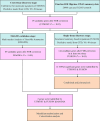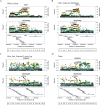A cross-tissue transcriptome-wide association study reveals novel susceptibility genes for migraine
- PMID: 38840241
- PMCID: PMC11151630
- DOI: 10.1186/s10194-024-01802-6
A cross-tissue transcriptome-wide association study reveals novel susceptibility genes for migraine
Abstract
Background: Migraine is a common neurological disorder with a strong genetic component. Despite the identification of over 100 loci associated with migraine susceptibility through genome-wide association studies (GWAS), the underlying causative genes and biological mechanisms remain predominantly elusive.
Methods: The FinnGen R10 dataset, consisting of 333,711 subjects (20,908 cases and 312,803 controls), was utilized in conjunction with the Genotype-Tissue Expression Project (GTEx) v8 EQTls files to conduct cross-tissue transcriptome association studies (TWAS). Functional Summary-based Imputation (FUSION) was employed to validate these findings in single tissues. Additionally, candidate susceptibility genes were screened using Gene Analysis combined with Multi-marker Analysis of Genomic Annotation (MAGMA). Subsequent Mendelian randomization (MR) and colocalization analyses were conducted. Furthermore, GeneMANIA analysis was employed to enhance our understanding of the functional implications of these susceptibility genes.
Results: We identified a total of 19 susceptibility genes associated with migraine in the cross-tissue TWAS analysis. Two novel susceptibility genes, REV1 and SREBF2, were validated through both single tissue TWAS and MAGMA analysis. Mendelian randomization and colocalization analyses further confirmed these findings. REV1 may reduce the migraine risk by regulating DNA damage repair, while SREBF2 may increase the risk of migraine by regulating cholesterol metabolism.
Conclusion: Our study identified two novel genes whose predicted expression was associated with the risk of migraine, providing new insights into the genetic framework of migraine.
Keywords: Colocalization; Cross-tissue TWAS; Mendelian randomization; Migraine; UTMOST.
© 2024. The Author(s).
Conflict of interest statement
The authors declare no competing interests.
Figures





Similar articles
-
A cross-tissue transcriptome-wide association study identified susceptibility genes for age-related macular degeneration.Sci Rep. 2025 Feb 8;15(1):4788. doi: 10.1038/s41598-025-89246-z. Sci Rep. 2025. PMID: 39922885 Free PMC article.
-
A cross-tissue transcriptome-wide association study reveals GRK4 as a novel susceptibility gene for COPD.Sci Rep. 2024 Nov 18;14(1):28438. doi: 10.1038/s41598-024-80122-w. Sci Rep. 2024. PMID: 39558015 Free PMC article.
-
A cross-tissue transcriptome-wide association study identifies new susceptibility genes for benign prostatic hyperplasia.Sci Rep. 2025 Jan 25;15(1):3186. doi: 10.1038/s41598-025-87651-y. Sci Rep. 2025. PMID: 39863741 Free PMC article.
-
Multiome-wide Association Studies: Novel Approaches for Understanding Diseases.Genomics Proteomics Bioinformatics. 2024 Dec 3;22(5):qzae077. doi: 10.1093/gpbjnl/qzae077. Genomics Proteomics Bioinformatics. 2024. PMID: 39471467 Free PMC article. Review.
-
Advances in the genetics of myasthenia gravis: insights from cutting-edge neuroscience research.Front Med (Lausanne). 2025 Jan 7;11:1508422. doi: 10.3389/fmed.2024.1508422. eCollection 2024. Front Med (Lausanne). 2025. PMID: 39845831 Free PMC article. Review.
Cited by
-
scTWAS Atlas: an integrative knowledgebase of single-cell transcriptome-wide association studies.Nucleic Acids Res. 2025 Jan 6;53(D1):D1195-D1204. doi: 10.1093/nar/gkae931. Nucleic Acids Res. 2025. PMID: 39420631 Free PMC article.
-
A Cross-Tissue Transcriptome-Wide Association Study Reveals Novel Susceptibility Genes for Diabetic Kidney Disease in the FinnGen Cohort.Biomedicines. 2025 May 19;13(5):1231. doi: 10.3390/biomedicines13051231. Biomedicines. 2025. PMID: 40427057 Free PMC article.
-
A cross-tissue transcriptome-wide association study identified susceptibility genes for age-related macular degeneration.Sci Rep. 2025 Feb 8;15(1):4788. doi: 10.1038/s41598-025-89246-z. Sci Rep. 2025. PMID: 39922885 Free PMC article.
-
Integrative genetics and multiomics analysis reveal mechanisms and therapeutic targets in vitiligo highlighting JAK STAT pathway regulation of CTSS.Sci Rep. 2025 Jan 17;15(1):2245. doi: 10.1038/s41598-025-86134-4. Sci Rep. 2025. PMID: 39824912 Free PMC article.
-
Cross-Tissue Transcriptome-Wide Association Study Identifies Novel Genes Associated With POAG.Invest Ophthalmol Vis Sci. 2025 Jun 2;66(6):7. doi: 10.1167/iovs.66.6.7. Invest Ophthalmol Vis Sci. 2025. PMID: 40459497 Free PMC article.
References
-
- Migraine (2022) Nat Rev Dis Primers 8(1:1). 10.1038/s41572-022-00335-z - PubMed
MeSH terms
LinkOut - more resources
Full Text Sources
Medical

